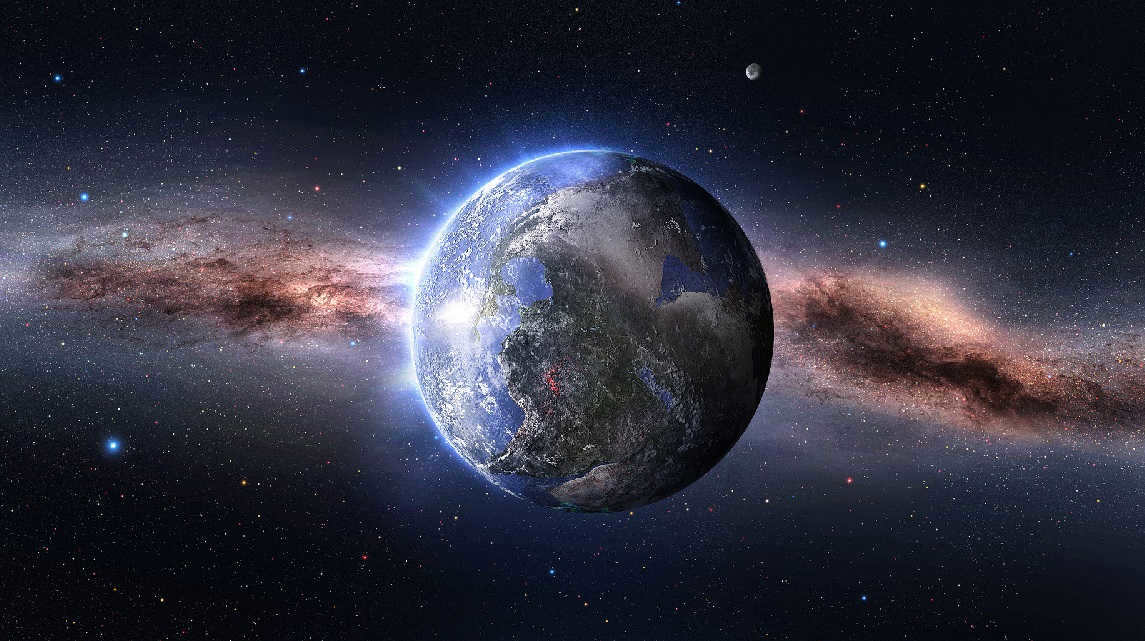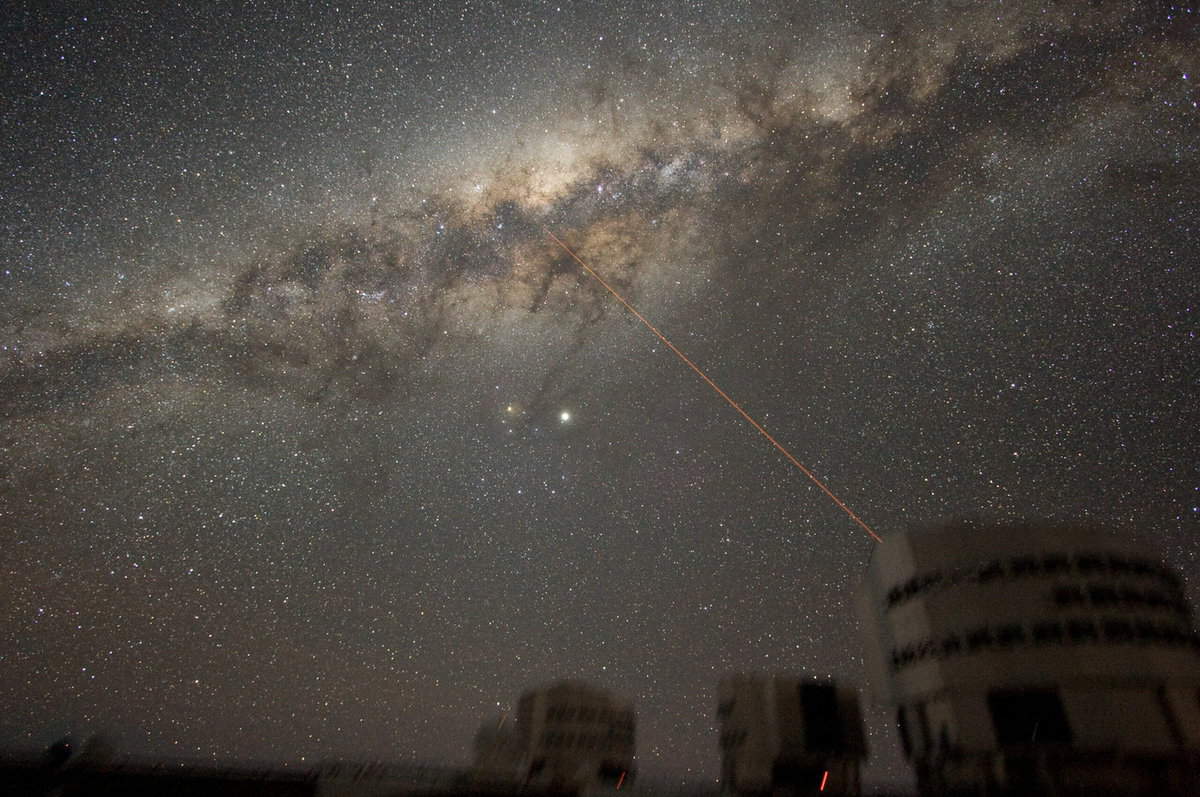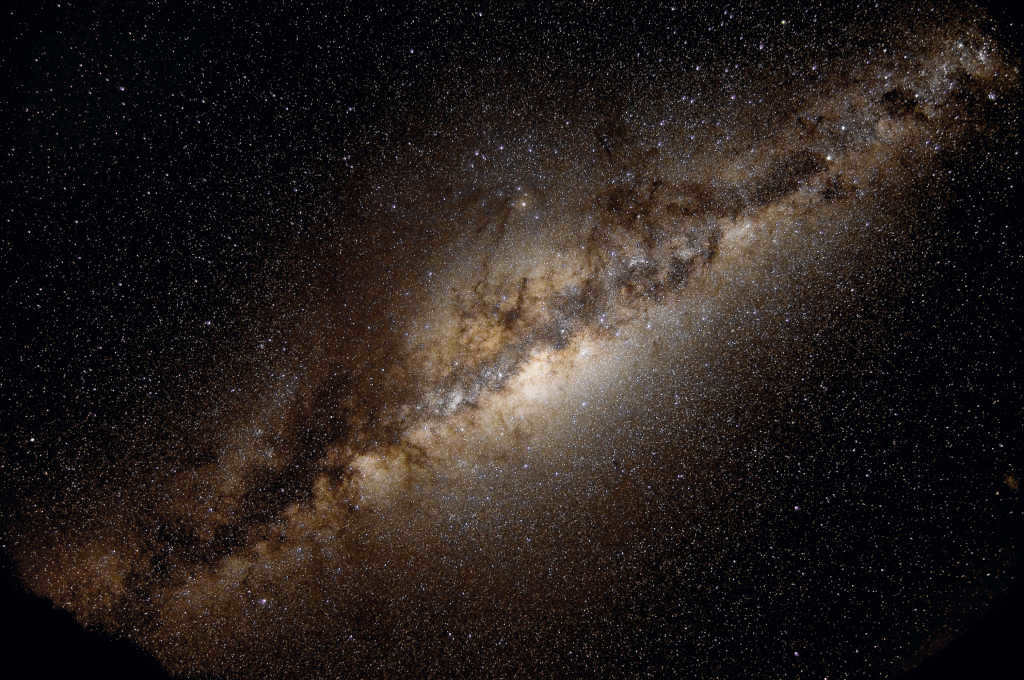

Throughout history, humanity has held a deep fascination with the celestial realm. Gazing up at the night sky unaided reveals a luminous strip comprised of countless stars and interstellar matter. This celestial strip has been referred to as the Milky Way since ancient times.
Our home is the Milky Way galaxy
Materials that are connected
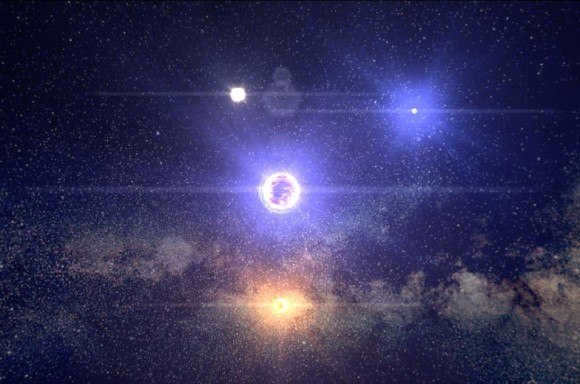
Our galaxy remains an enigma to many individuals. While a plethora of facts are known about it, I can assure you that there are numerous unanswered questions that persist.
In the present day, we possess highly accurate observational equipment and comprehend that this band signifies the galaxy in which our solar system resides. This galaxy is known as the Milky Way. As we are situated within it, or more precisely on its periphery, determining the shape of the Galaxy proves to be quite challenging. Nonetheless, it is widely believed that our galaxy bears resemblance to the Andromeda Galaxy and exhibits a spiral shape with a junction. Prior to 2005, it was commonly thought that our galaxy was solely a spiral galaxy. However, observations made by the Spitzer Space Telescope have confirmed the existence of a junction.
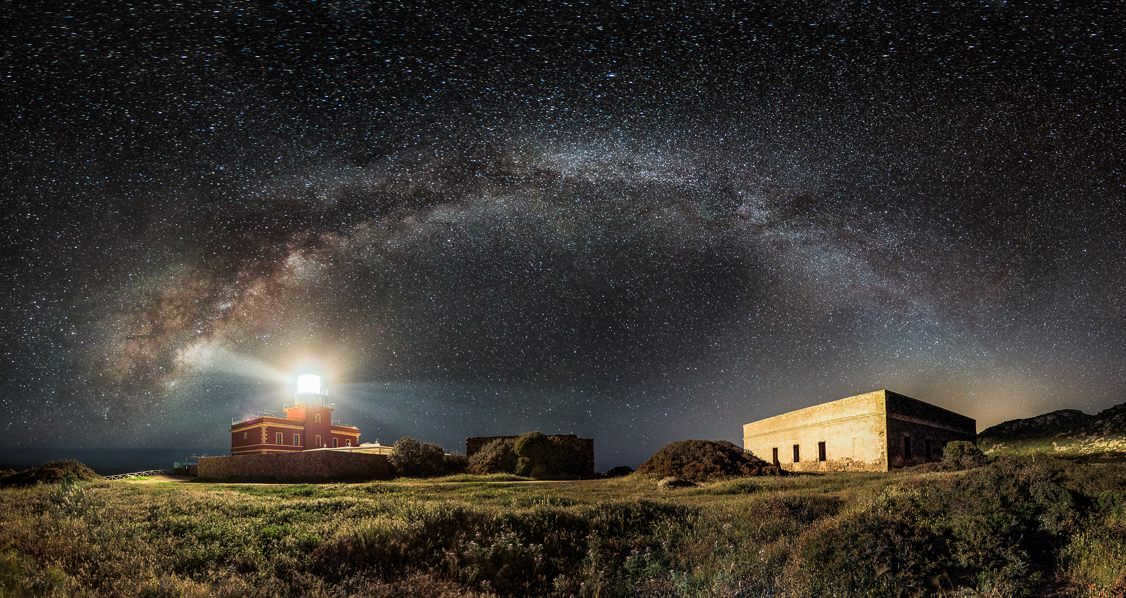
A lighthouse is visible against the backdrop of our star-filled island
The composition of the galaxy
Resources related to the subject
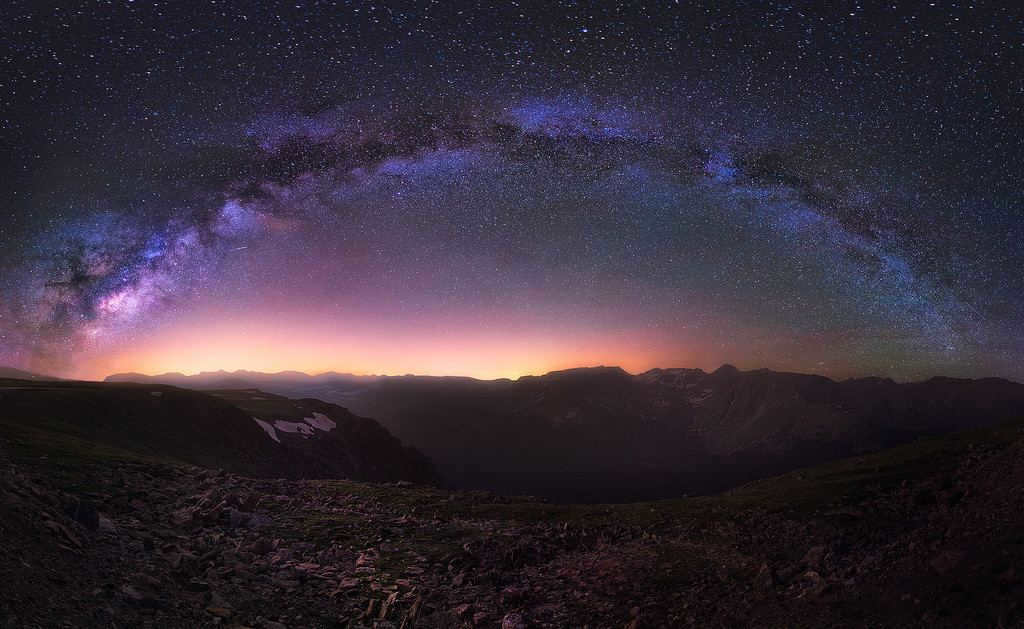
The Galaxy has a general appearance similar to that of a disk, measuring 80,000 light-years (or 25,000 parsecs) in diameter and approximately 1,000 light-years thick. Located at the center of the galaxy is the Bulge, which consists of aging stars that move in elongated orbits around a supermassive black hole called Sagittarius A. Our Bulge extends for a distance of 8,000 parsecs.
Spiral Formation
Due to its spiral formation, the Milky Way showcases spiral arms within its disk. The observation of these arms is challenging for us, as our solar system is located 8,500 parsecs from the center of the galaxy, specifically on the inner edge of the Orion arm. Recent findings reveal the presence of two additional arms originating from the intersection in the inner region of the galaxy.
In addition, there are several more arms within the inner part, resulting in a four-arm configuration. Surrounding the Galaxy’s disk is a spherical structure known as the Galactic Halo, which extends 5,000 to 10,000 light years beyond the galaxy. Comprised of hot gas, stars, and dark matter, the halo adds to the overall composition of the Milky Way.
Gallery of Images
Based on rough approximations, the Milky Way contains approximately 400 billion stars, weighing about 5×10*11 times the mass of our Sun. Interestingly, the majority of this mass is not found in stars or interstellar gas, but rather in the enigmatic substance known as dark matter, which forms the galaxy’s halo.
Similar to many other galaxies, the center of the Milky Way harbors a supermassive black hole called Sagittarius A. This colossal black hole is situated roughly 26,000 light years away from Earth and boasts a size of approximately 22.5 million kilometers.
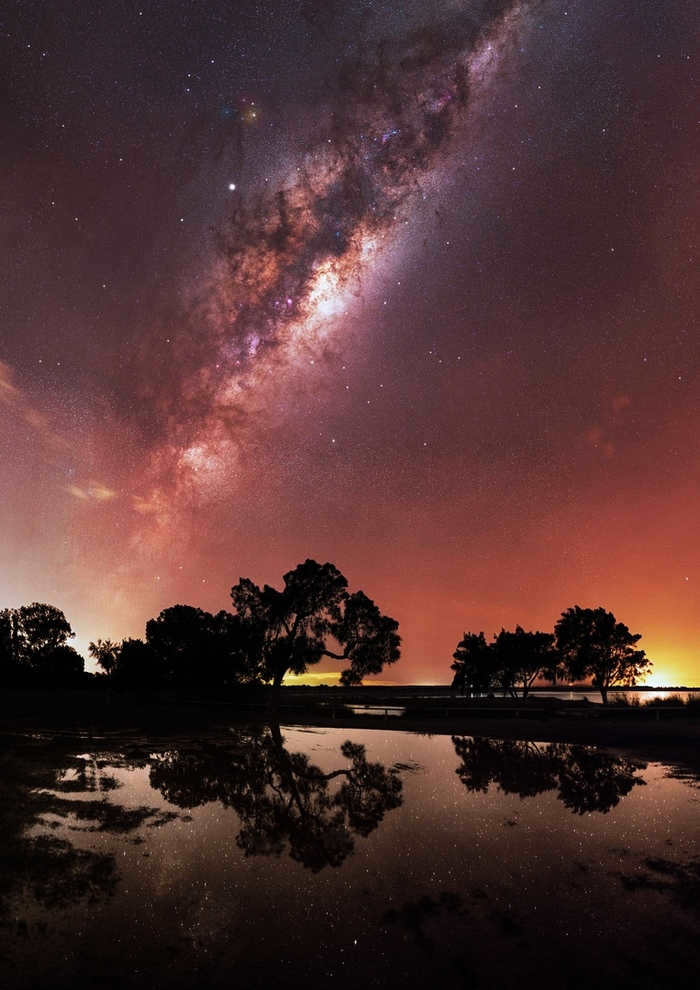
Space exploration is an incredible phenomenon, and I often imagine what it would be like to be born in the year 3305, where technology is advanced like it is in Elite Dangerous. In this futuristic world, one could save up enough money to have their own spaceship and embark on thrilling and perilous adventures in the vast expanse of space.
This concept is truly awe-inspiring. Am I the only one who experiences a sense of anxiety when faced with the dilemma of deciphering text within an image or comprehending the context of an image based on accompanying text? It would be so much simpler if the text and image were presented together in a cohesive manner.
Although my opinion may not be as profound, I still wanted to share my thoughts on the matter.
I find myself somewhere between Perm and Yekaterinburg on September 17.
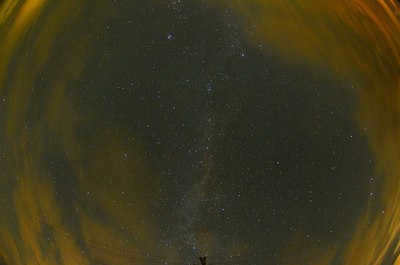
The bay in Cape Cod, Massachusetts is illuminated by the breathtaking sight of the Milky Way galaxy
Imagine if you could journey one billion years ahead in time, just to witness the incredible changes that would unfold before your eyes
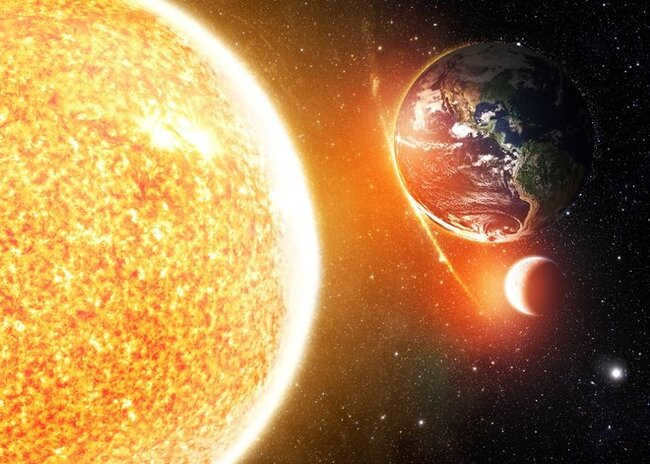
An artistic illustration showcasing the eventual demise of our planet
The solar system will undergo significant changes during this time period, and I will now elaborate on them. By then, Saturn will have shed its iconic rings, as they gradually dissipate into its atmosphere. We are fortunate to exist in a time where we can witness the awe-inspiring beauty of Saturn in its entirety.
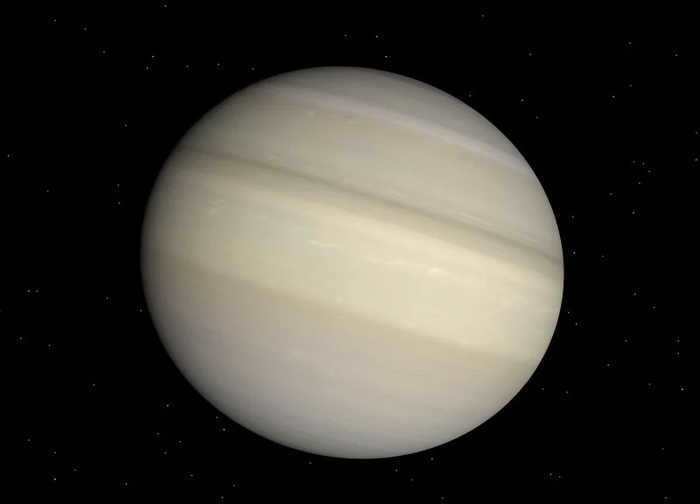
An imaginative portrayal of Saturn devoid of its iconic ring system.
However, in the distant future of one billion years, the planet Mars will possess its own set of rings. Over time, Mars’ moon Phobos is progressively descending towards the planet’s surface. Ultimately, the gravitational forces exerted by Mars will cause Phobos to disintegrate. According to scientific estimates, this event is anticipated to occur within a span of 40-50 million years.
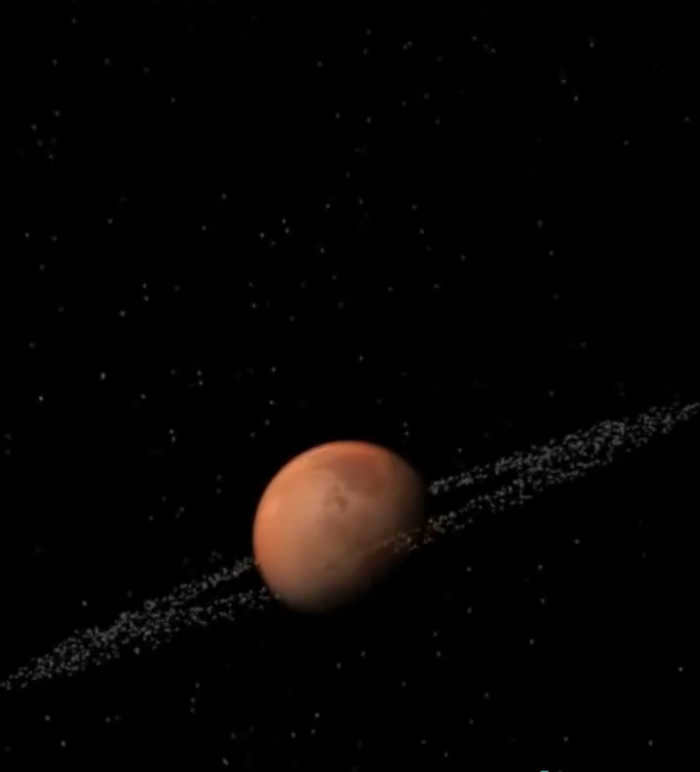
Throughout its existence, our small planet Mercury has always been the closest to the Sun. However, despite its proximity and surface temperature reaching above 400°C, Mercury is still able to maintain frozen water in the shadows at its poles. Over time, the aging Sun will gradually vaporize this ice and eventually engulf the entire planet.
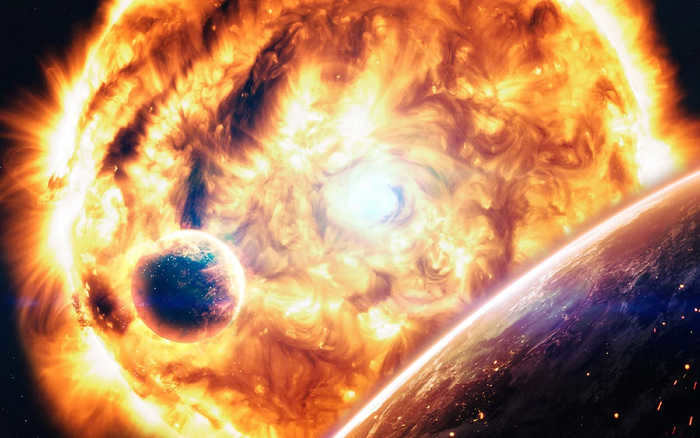
Venus, often referred to as the “Sibling of Earth”, shares similarities with our planet in terms of size, mass, and composition. However, it is drastically different in terms of its surface conditions. The planet’s surface is characterized by a menacing environment, featuring an incredibly dense atmosphere that induces a potent greenhouse effect. Consequently, the surface temperature on Venus reaches a scorching 467°C. Regrettably, in a billion years, the existence of Venus will cease to exist as a result of the Sun’s expansion, which will lead to the incineration of its atmosphere, and ultimately the destruction of the entire planet. The same fate awaits Mercury as well.
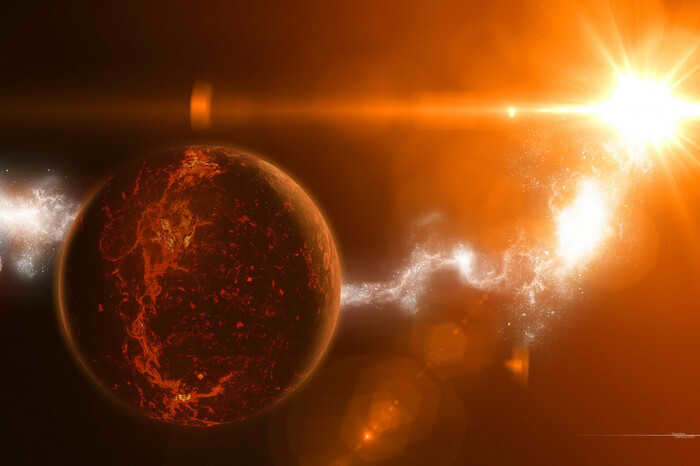
However, the fate of Earth is uncertain. There is a possibility that a massive celestial object could collide with Earth, a phenomenon that occurs approximately every 100 million years. Alternatively, it’s plausible that the Earth/Moon system could be propelled outward after the destruction of Mercury and Venus, sparing us from the same fate as our neighboring planets. Another scenario is that the Sun will undergo such a significant expansion that solar radiation becomes unbearably intense.

An artistic representation of the Earth, which has become dry and barren, is depicted.
In the future, when you use a time machine to travel one billion years ahead, you will witness the closest large galaxy, Andromeda, approaching us at a remarkable speed of 120 kilometers per second. It will be so near that its brightness in the night sky will be comparable to that of several moons (as shown in the second frame in the image above).
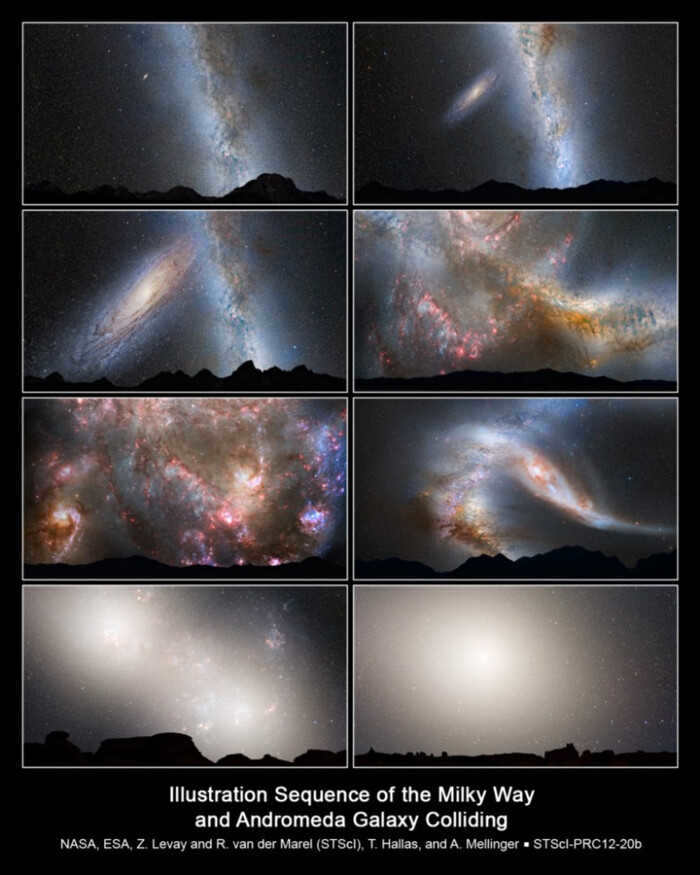
In approximately 3-5 billion years from now, the Andromeda galaxy is predicted to merge with our own Milky Way galaxy, resulting in a significant transformation of both galaxies and the nighttime celestial view. Currently, the Andromeda galaxy is located about 2.5 million light-years away, but according to the most accurate simulations, the initial collision and subsequent burst of star formation (as depicted in frame 4 of the above image) will occur in approximately 3.8 billion years, coinciding with the “second Universal Year”. This merging process is anticipated to conclude within 5.5 billion years.
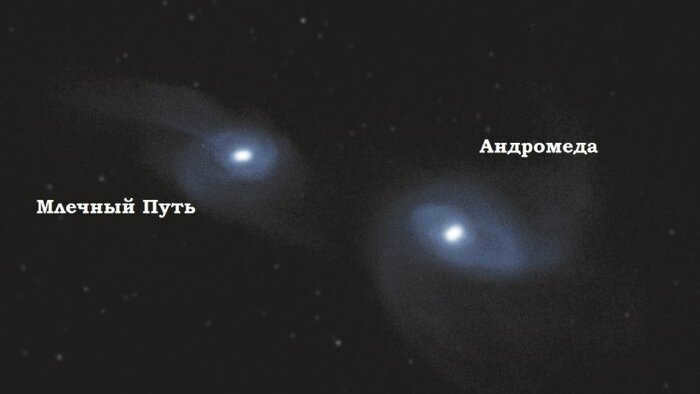

The galaxy of Vera Rubin
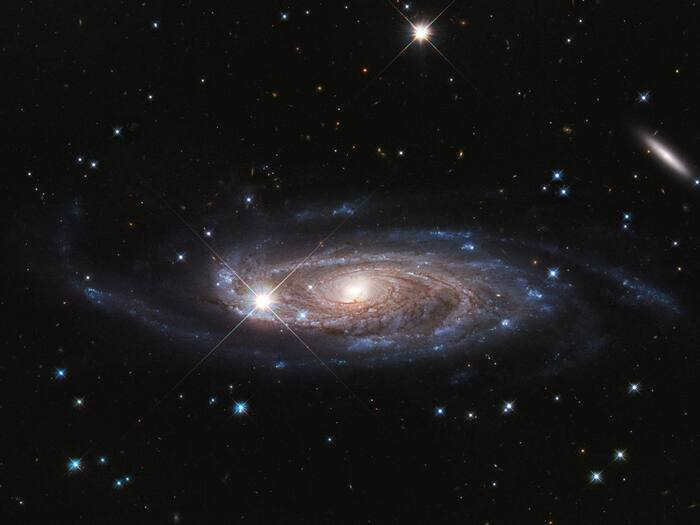
Within this picture taken by the Hubble Space Telescope, one can observe luminous stars encompassed by diffraction rays located in the northern constellation Perseus and our very own Milky Way Galaxy. Positioned behind them, the image unmistakably focuses on the immense spiral galaxy UGC 2885, which lies approximately 232 million light-years away. With a diameter of roughly 800 thousand light-years, UGC 2885 surpasses the size of the Milky Way, which measures at 100 thousand light-years. UGC 2885 is home to an astonishing 1 trillion stars, a number ten times greater than that of the Milky Way. This colossal galaxy, UGC 2885, has become the focal point of scientific inquiry, as astronomers strive to comprehend how galaxies of such magnitude come to be. Astronomer Bepa Rubin harnessed the potential of this galaxy in her groundbreaking investigation of the rotational patterns within spiral galaxies. Her pioneering work is chronicled in her autobiographical article entitled “An Interesting Journey,” wherein she effectively demonstrates the paramount influence of dark matter within our vast Universe.
Russia has created and patented an innovative helicon plasma rocket engine with an incredibly long-lasting resource
News has emerged that experts from the S.P. Energia Rocket and Space Corporation have successfully developed and patented a groundbreaking helicon plasma rocket engine with an almost boundless operational lifespan. The Korolev (a part of Roscosmos) has obtained a patent for this exceptional design of a helicon electric rocket plasma engine, which holds great potential for future space missions both in close proximity to Earth and in the vast expanse of deep space.
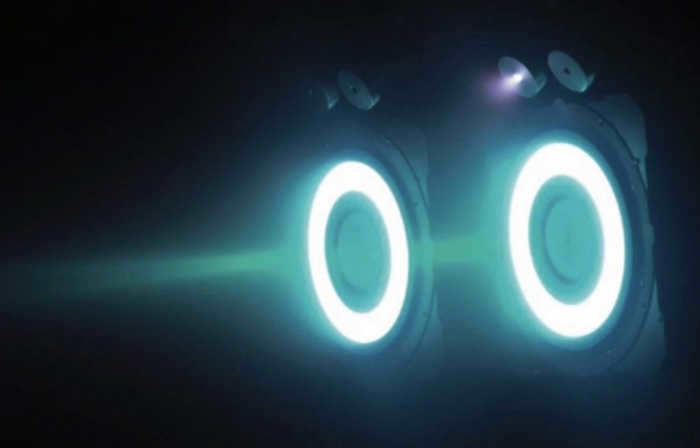

The functioning of ion thrusters. Image source: scmp.com
What makes electric rocket engines unique and what sets domestic development apart?
The unique aspect of electric rocket engines is their ability to operate for decades without interruption, relying solely on electricity, unlike traditional chemical-fueled rockets.
If we examine existing launch vehicles and spacecraft, we will find that up to 90% of their total weight is fuel. Electric rocket engines, on the other hand, can free up a significant amount of space on the rocket, resulting in a substantial increase in payload mass.
The development by domestic engineers at RSC Energia aims to reduce the overall weight of one of the existing types of electric rocket engines, specifically the magnetoplasma electrodeless engine with cyclotron plasma acceleration in an axial magnetic field.
The concept of helicon pertains to electromagnetic waves with low frequencies that occur within a plasma subjected to a steady external magnetic field.
In this type of propulsion system, a unique arrangement of magnets generates an immensely powerful magnetic field, through which the working substance, which can be any material (such as gases, including nitrogen, abundantly available in outer space), flows.
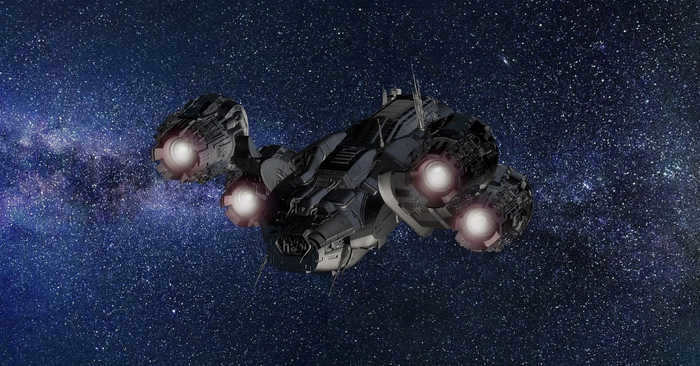

A spacecraft traversing the depths of space
Upon traversing this magnetic system, the gas (propellant) undergoes a transformation into plasma through the utilization of helicon waves, which, upon expulsion, generates the necessary propulsive force.
Due to the absence of electrodes submerged in the plasma (unlike ionic propulsion systems), these designs possess an immense mean time between failures (MTBF). Additionally, damage to the walls of the combustion chamber is minimized, and there are no moving components.
Russian specialists have successfully developed a magnetic system design that effectively combines the working body transportation system, resulting in a significant reduction in the mass of the helicon rocket engine.
As a result, additional kilograms have been freed up in the rocket, which can now be allocated to other scientific equipment.
We will closely monitor the progress in this field and eagerly await the testing of such an engine in space.
Did you find the article interesting? Then I recommend checking out my Telegram channel dedicated to space (Space is near). It covers all the latest developments in the field and will soon host a space poster raffle as well)
Astronomers have made a remarkable discovery of a planet with a remarkably similar atmosphere to Earth’s.
A team of international researchers, led by scientists from NASA’s Jet Propulsion Laboratory, have identified a previously unknown exoplanet that possesses an atmosphere eerily reminiscent of our own planet. Furthermore, this newfound planet boasts a climate that is surprisingly temperate.
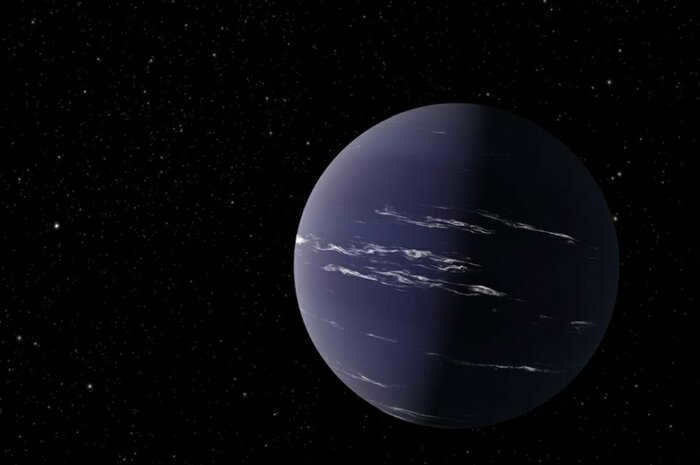

The recently discovered planet and its unique characteristics
Scientists have given the name TOI-1231 b to the remarkable exoplanet they have just uncovered. This planet, despite its less melodic name, was identified through thorough analysis of data collected from the Transiting Exoplanet Survey Satellite (TESS).
But that’s not all – the existence of this planet has also been independently verified through observations made using the extraordinary spectrograph device, Planet Finder (PFS), which is ingeniously mounted on the Magellan Clay telescope situated in the picturesque landscapes of Chile.
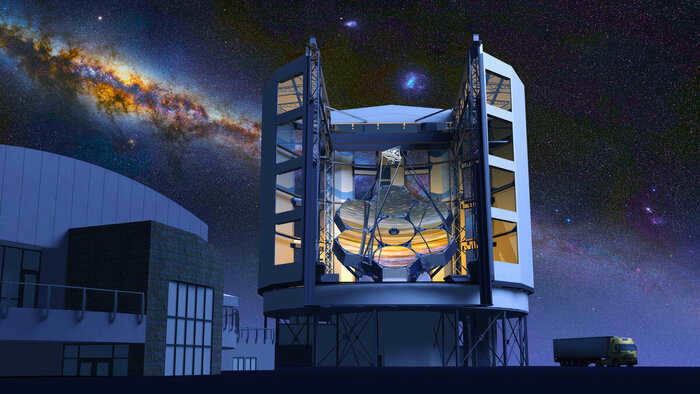
According to the primary author of the research, D. Burt, the comprehensive range of studies and accurate determination of most of the characteristics of the host star, as well as the radius and size of the exoplanet, were made possible by collaborating with highly qualified experts from around the world.
As a result, it is evident that TOI-1231 b shares a striking resemblance in terms of size and density with Neptune. This has led astronomers to speculate that the planet’s atmosphere may also possess a similar gaseous composition.
What do we know about the planet
Astronomers have determined that the planet known as TOI-1231 b revolves around a dwarf gas planet that falls under the category of class M planets. Despite being approximately eight times closer to its host star compared to the Earth’s distance from the Sun, the surface temperature of this exoplanet is remarkably similar to that of our own planet.
Astronomers have attributed this temperature phenomenon to the fact that the star it orbits is significantly colder and dimmer than our Sun. Additionally, the discovered planet is larger than Earth but smaller than Neptune, classifying it as a sub-Neptune.
There is still much work for scientists to do in order to analyze the atmosphere of the open planet. However, it is already observed that this planet is highly suitable for studying the atmosphere compared to other exoplanets that have been discovered so far.
Based on previous research, it is highly probable that clouds can form in the upper layers of the atmosphere on these relatively cold planets, making their atmospheres more similar to that of Earth.
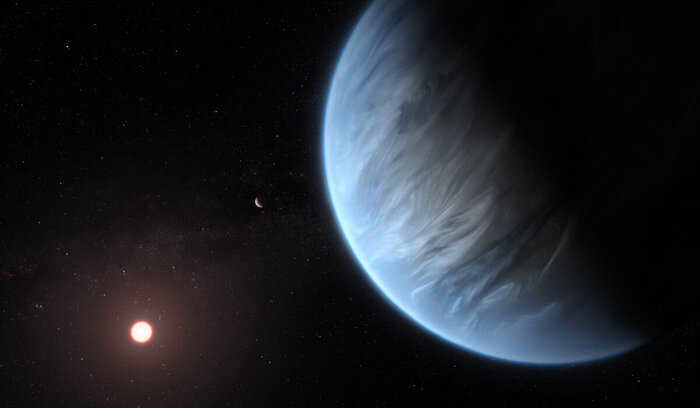

The discovery of water traces in the atmosphere of planet K2-18b has led to a comparison with our own planet. This finding has surprised scientists greatly.
Another planet, TOI-1231 b, shares many similarities with K2-18b. Further research on this planet will help determine the frequency of water cloud formations in the atmosphere of such temperate exoplanets.
Did you enjoy the article? If so, I recommend checking out my Telegram channel about space Space is just around the cornerall the excitement is happening there). Additionally, we will soon be hosting a giveaway for space posters).

Astrohobby #32. The North America Nebula. The Mine of Friday
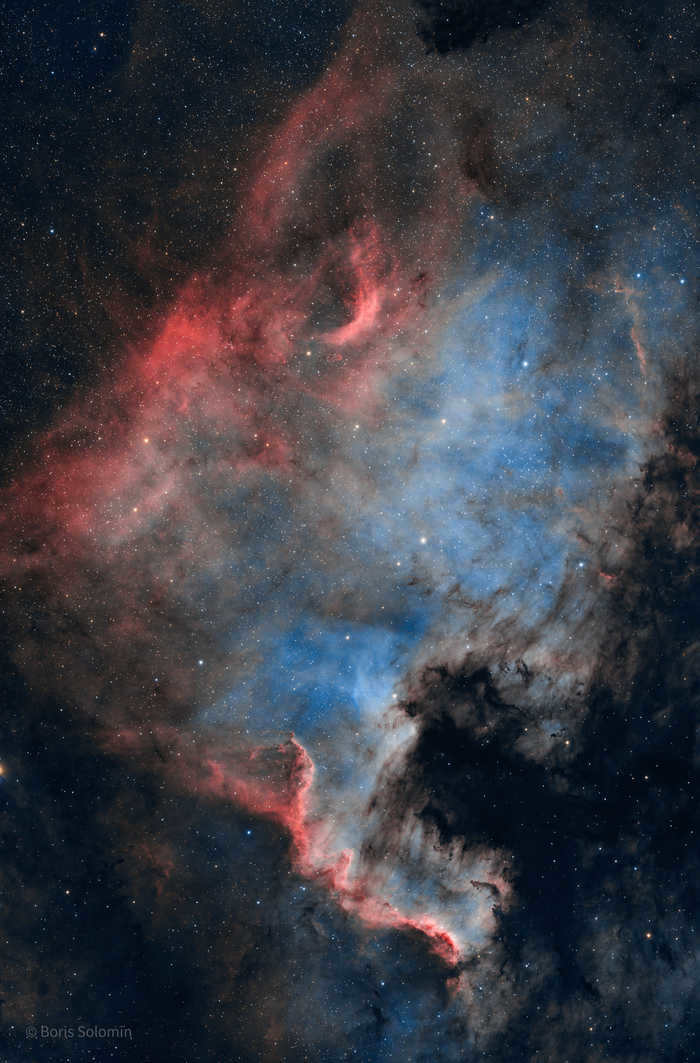
Overall, I captured approximately 14 hours of footage using my telescope. I spent half an hour specifically focusing on capturing the stars in their natural color using a broadband filter. The remaining 13.5 hours were dedicated to capturing light from ionized hydrogen and oxygen using a narrowband filter. This allowed me to create interesting color palettes, with hydrogen appearing in the red channel and oxygen in the blue and green channels. I used the HOO->RGB technique to process the final image.
You can find the original uncompressed image and technical information at this link: https://www.astrobin.com/lhdoiv/
The North America Nebula (NGC 7000 or Caldwell 20) is an emission nebula located in the constellation Cygnus, close to the star Deneb (the tail of the swan and its brightest star). It derives its name from its resemblance to the outline of the continent of North America.
On October 24, 1786, William Herschel, while observing from Slough, England, made note of “a faint milky haze scattered in space, in some areas quite bright.” The most remarkable region was officially cataloged by his son John Herschel on August 21, 1829, and it was given the designation NGC 7000 in the New General Catalog.
In 1890, German astrophotographer Max Wolf discovered the distinct shape of this nebula in a long exposure photograph and named it the North America Nebula.
In 1959, while examining the nebulae on the Palomar Sky Survey tiles, American astronomer Stuart Sharpless made an intriguing observation. He noticed that the North America Nebula and the Pelican Nebula, previously thought to be separate entities, were actually connected. Sharpless discovered that these two nebulae were part of the same interstellar cloud of ionized hydrogen, known as region H II. They were only separated by a dark band of dust. As a result of this discovery, Sharpless decided to combine the two nebulae into his second list of 313 bright nebulae, which he numbered as Sh2-117.
Further observations have revealed that J205551.3+435225 is classified as an O3.5 spectral type star, and it is accompanied by another O8 type star in its orbit. Situated close to the “Florida coast” of the North America Nebula, this star has been given the name Bahamar. The term “Islas de Bajamar” translates to “low tide islands” in Spanish, which was originally used to describe the Bahamas due to the fact that many of its islands are only visible from a ship during low tide.
Despite being heavily obscured by the dark cloud L935, Star Bahamar’s light is attenuated by 9.6 stellar magnitudes (equivalent to almost 10,000 times). As a result, it is only faintly visible in optical wavelengths, with a brightness of 13.2. If this star were seen without any attenuation, it would shine with a brightness of 3.6, comparable to Albireo, the star that serves as the swan’s head marker.
The distances to the North American and Pelican nebulae have long been the subject of debate among astronomers due to the limited methods available for accurately determining the distance to the HII region. Up until 2020, the widely accepted value was 2,000 light-years, although estimates varied between 1,500 and 3,000 light-years.
However, in 2020, the Gaia astrometric spacecraft conducted measurements on 395 stars within the HII-region, providing new insights. The data revealed that the North American Nebula and Pelican Nebula are located approximately 2,590 light-years (or 795±25 parsecs) away. Furthermore, it was determined that the entire HII-region of Sh2-117 spans approximately 140 light-years in width, with the North American Nebula stretching 90 light-years from its northern to southern extent.
MILKY WAY, is a faint glow in the night sky caused by the countless number of stars in our Galaxy. The Milky Way forms a wide ring that encircles the entire sky. To get the best view of the Milky Way, it is recommended to observe it away from the bright lights of the city. In the Northern Hemisphere, the ideal time to observe the Milky Way is around midnight in July, 10 p.m. in August, or 8 p.m. in September. During these times, the Northern Cross of the constellation Swan will be close to the highest point in the sky, known as the zenith. By following the shimmering band of the Milky Way towards the north or northeast, you will pass by the constellation Cassiopeia, which is shaped like a W, and continue towards the bright star Capella. Beyond Capella, you can see the smaller and brighter section of the Milky Way as it passes just east of Orion’s Belt and slopes down towards the horizon, near the brightest star in the sky, Sirius. The brightest portion of the Milky Way can be seen in the south or southwest while the Northern Cross is directly overhead. During this time, two branches of the Milky Way are visible, separated by a dark gap. Additionally, halfway to the zenith, there is a cloud in the Shield that astronomer E. Barnard referred to as “the jewel of the Milky Way.” Below this cloud, you can see the stunning constellations of Sagittarius and Scorpius.
Regrettably, Northern Hemisphere observers do not have access to the most brilliant sections of the Milky Way. In order to view them, one must travel to the equator, or preferably position themselves between 20°S and 40°S and gaze at the sky around 10 pm in late April or early May. During this time, the Southern Cross can be seen high in the sky, while Sirius is visible in the northwest at a lower altitude. Spanning between them is the faint and narrow Milky Way, which becomes considerably brighter and more captivating approximately 30° west of the Southern Cross, within the constellation of Carina. As Sagittarius and Scorpius ascend in the east, the most radiant and breathtaking sections of the Milky Way become visible. Its most remarkable area can be observed in the late evening during June and July, when the Sagittarius Cloud is positioned near the zenith. Against the uniform glow produced by numerous distant stars, which are indistinguishable to the naked eye, dark clouds and “veins” of frigid cosmic dust can be discerned. Those who wish to comprehend the structure of our Galaxy should take the opportunity to observe the Milky Way – this genuinely extraordinary and most magnificent of celestial phenomena.
All you need is a pair of binoculars or a small telescope to distinguish the countless stars that form the Milky Way. The Sagittarius and Scorpius constellations have the highest concentration of stars and the widest part of the Milky Way. On the opposite side of the sky, near Orion’s Belt and Capella, there are fewer stars. Precise astronomical observations confirm the initial visual impression: the Milky Way band represents the central plane of a massive disk-shaped star system known as our Galaxy or the Milky Way Galaxy. Our Sun, one of the stars in this galaxy, is located near the central plane but not at its center. Instead, it is positioned two-thirds of the way from the center to the edge. The stars that form the Milky Way are at different distances from Earth. Some are as close as 100 light-years, while most are 10,000 light-years away or even farther. The star cloud in Sagittarius and Scorpius points towards the center of the Galaxy, which is approximately 30,000 light-years away from Earth. The entire Galaxy has a diameter of at least 100,000 light-years.
The Milky Way consists primarily of stars that are similar to the Sun in size. Some of these stars are larger and brighter than the Sun, while others are smaller and dimmer. The Sun, in comparison, is considered an average star. Stars come in different colors depending on their surface temperature. The hottest stars are blue-white and have temperatures ranging from 20,000 to 40,000 K, while the coolest stars are red and have temperatures around 2,500 K.
Star clusters are formed by some stars grouping together. Some of these clusters, like the Pleiades, can be seen with the naked eye. These clusters usually have 50 to 2000 stars. There are also larger clusters called globular clusters that can have several million stars. The age and composition of these clusters can vary greatly. Scattered clusters are relatively young, with an average age of about 10 million years, which is about 1/500th the age of the Earth and the Sun. They have many bright, massive stars. Globular clusters, on the other hand, are very old, with an age of 10-15 billion years. They are made up of the oldest stars in the Galaxy, with only low-mass stars surviving. Scattered clusters are found near the galactic plane, where there is a lot of interstellar gas that forms stars. Globular clusters, on the other hand, are located in the galactic halo surrounding the disk and are concentrated towards the center of the Galaxy.
The Galaxy has a minimum mass of 2Ch10 11 solar masses, mainly consisting of stars. However, around 5% of its mass is comprised of interstellar matter, which includes gas and dust. This interstellar matter is found in the space between stars in a galactic disk that is approximately 600 sv. years thick. Within this disk, the interstellar matter is concentrated towards the spiral arms of the Galaxy. A significant portion of the interstellar matter is gathered in large cold clouds, where stars are formed in their interior. For more information, please refer to. also INTERSTELLAR MATTER.
Test your knowledge!
Respond to the queries of the Astronomy Quiz
Which celestial body was the most recently found in our solar system?
Andromeda and the Milky Way Configuration, chart of the Milky Way Galaxy
In this piece, we have gathered responses to the most frequently asked questions about the Milky Way. Peruse the article to discover what the Milky Way is, our location within it, and the optimal time for observing it.
What is the Milky Way?
The Milky Way galaxy is an enormous assemblage of dust, gas, and numerous stars, which includes our very own Sun. Due to the fact that our planet is situated within this galaxy, the Milky Way is commonly known as “our galaxy.”
It may be difficult to fathom that this luminous band in the nocturnal heavens is indeed a colossal galaxy that extends billions of kilometers around our planet. Just how immense is it? Let’s ascertain.
The dimensions of the Milky Way
Within the Local Group of galaxies, the Milky Way occupies the second position in terms of size, coming after Andromeda. Its width spans 105,700 light years, whereas Andromeda stretches across 220,000 light years. Moreover, the Local Group of galaxies, a cluster that encompasses several dozen galaxies, measures 10 million light years in size.
What is the origin of the name Milky Way?
The name Milky Way, along with many other celestial objects, originated from ancient Greece and ancient Rome. According to Greek and Roman mythology, a celestial band of stars was seen as a river of milk. The Greeks believed that the goddess Hera spilled milk across the sky, while ancient Roman myths attributed the Milky Way to the goddess Opa’s milk.
Various cultures had their own interpretations of our galaxy. In eastern Asia, it was referred to as the Silver Sky River; the Finns and Estonians called it the Bird’s Path, and in South Africa, it was believed to be the Ridge of Night.
There are four primary categories of galaxies: spiral, elliptical, lenticular, and irregular. The Milky Way, which has a spiral shape, falls into the first category. If viewed from above or below, it would appear as a large spinning spiral.
More specifically, the Milky Way is a spiral galaxy with a bar. The bar, known as the “lintel,” consists of a bright band of stars located in the galaxy’s center. Within this bar lies the galactic nucleus, and two spiral arms connect to its edges. In a typical spiral galaxy, the arms would lead directly to the galaxy’s center (nucleus), much like in the case of Andromeda, rather than to the lintel.
We are aware of four branches of the Milky Way: two primary branches linked at the junction (the Perseus branch and the Shield-Centaurus branch) and two smaller branches situated between the primary ones (the Sagittarius branch and the Naugol branch). Previously, scientists believed that all of these branches were primary, but through the utilization of infrared images from the Spitzer Space Telescope, they have discovered otherwise.
Where in the Milky Way is Earth situated?
Great news for those who never imagined being right next to a massive black hole: we are actually quite far from the center of the Milky Way. Our Sun is positioned approximately 27,000 light-years away from its core, which is roughly halfway between the galaxy’s center and its outermost region.
Our solar system can be found within a smaller arm known as the Orion arm or Orion’s Spur, nestled between the two primary arms. This particular arm stretches across a distance of about 3,500 light-years and spans over 20,000 light-years in length. It derives its name from the constellation Orion, where it can be observed. Our placement within this arm accounts for the abundance of bright objects that we see within the Orion constellation – we are essentially gazing upon our very own spiral arm that we call “home.”
What lies at the heart of the Milky Way?
The heart of our galaxy is referred to as the Galactic Center. It is home to a supermassive black hole known as Sagittarius A*, which boasts a mass exceeding 4 million times that of our sun. Glimpsing this extraordinary black hole would necessitate the use of a specialized radio telescope.
Remarkably, even the average person can observe the Galactic Center with the naked eye – despite its immense distance of 27,000 light years from Earth. The brightness of the galaxy’s core can be attributed to the staggering number of stars it harbors: approximately 10 million stars per parsec within the Galactic Center.
How can we determine the appearance of the Milky Way?
Due to our location within the Milky Way, it is challenging to ascertain its shape. As we are unable to venture beyond the galaxy’s confines, capturing a photograph from an external perspective is simply not feasible. However, we do possess several hints that have aided us in accurately visualizing the Milky Way:
- Astronomers meticulously observe other galaxies and draw comparisons to our own. By measuring the velocity of stars and gas within the Milky Way, they have discovered that our galaxy exhibits a straightforward and symmetrical rotation. This is a key characteristic of a spiral galaxy.
- The Milky Way has the same proportion of gas, color, and dust content as other spiral galaxies.
How can the Milky Way be observed?
The great thing is that regardless of where you are on Earth, the Milky Way can be seen throughout the year. However, due to the rotation of the Earth, its center, which is the brightest and most breathtaking part of the Milky Way, may sometimes be hidden from our view.
Here are a few important details to keep in mind when observing the Milky Way and the Galactic Center:
- The Galactic Center is located in the Capricorn constellation and, just like the constellation itself, can only be seen at latitudes between +55° and -90°. If you happen to live above +55°, unfortunately, you won’t be able to witness the Galactic Center! You will only be able to see a portion of it, which is best observed before and after summer.
- In the Northern Hemisphere, the Galactic Center is visible from March to October.
- From February through October, the galactic center is visible in the Southern Hemisphere.
- During the remaining months, the center of the Milky Way cannot be seen because it is too close to the Sun.
- In the southern latitudes, the conditions for observation are more favorable as the peak of visibility of the galactic center occurs in the winter season, when nights are longer and darker.
- At the beginning of the visibility season, the galactic center can be observed shortly before dawn. As time progresses, the period of visibility increases, reaching its peak in June and July. During these months, the center can be observed throughout the entire night.
- If you want to find a location with minimal light pollution, it is important to search for a place that is extremely dark. To achieve this, you can utilize resources such as NASA’s Blue Marble, International Dark Sky locations, and Dark Site Finder. Another option is to locate the nearest observatory, as they are typically situated in areas with minimal light pollution.
- In order to have optimal observing conditions, it is essential for the sky to be clear and free of clouds. To determine when such a night will occur, you can utilize an astronomy application that provides information on observing conditions. One example is the free app Sky Tonight, which can be used without an internet connection.
- The phase of the moon plays a crucial role in stargazing. The ideal scenario is to have a new moon, as this will ensure that the moon’s light does not interfere with observations.
Frequently Asked Questions
What is the total number of stars in the Milky Way galaxy?
Providing an exact figure is a challenging task; however, it is estimated that there are at least 100 billion stars in the Milky Way. The scientific community believes that the number could potentially range from 100 billion to 400 billion.
How many planets can be found within the Milky Way Galaxy?
Scientists have approximated that our galaxy is home to a minimum of 100 billion planets, out of which over 10 billion have similarities to Earth.
In the whole Milky Way galaxy, there is only one solar system, which we officially call the solar system. However, astronomers have made fascinating discoveries of over 3,200 other stars in the Milky Way that have planets orbiting around them.
How many constellations does the Milky Way pass through?
The Milky Way passes through a total of 30 constellations along its band. The constellation Capricorn is where the galactic center, the brightest part of the Milky Way, can be found.
We trust that this article has addressed the most popular inquiries about the Milky Way. Feel free to reach out to us on social media with any additional questions or share your own observations.
May your skies always be clear and your observations fruitful!
A third of the world’s population don’t know where to find the Milky Way
The ancient Babylonians associated the group of twinkling lights in the night sky with their revered deity, Tiamat, believing it to be the tail of their goddess. Ancient Greek communities believed that this luminous streak was the source of Hercules’ divine power. However, it wasn’t until the 17th century that Galileo provided a definitive answer to this intriguing question. Through his telescope, he discovered the optimal location to observe the Milky Way. Upon closer examination, Galileo concluded without a doubt that it was simply a collection of stars.
The Night Sky and the Milky Way
Scientists have determined that the Milky Way is a spiral galaxy with a central bulge. This galaxy consists of various components, including:
- Earth;
- the solar system;
- 200-400 billion other stars that are visible to the naked eye.
The Milky Way has a diameter of approximately 100,000 light-years and an average thickness of 1,000 light-years. Its shape resembles a flat disk. The structure of the galaxy includes:
- A disk that rotates faster than the halo and contains most of the stars near the plane;
- A central nucleus located in the Sagittarius constellation, which houses a massive black hole;
- Spiral arms, one of which is the Orion arm that includes our solar system, positioned towards the inner edge of the disk;
- The spherical dark matter halo extends beyond the Galaxy.
Speculation has arisen regarding the fate of the Magellanic clouds, both small and large, as they are predicted to eventually be engulfed by the Milky Way galaxy in approximately 250 million years. Furthermore, it is proposed that in another billion years, our very own Milky Way will face a similar fate at the hands of the Andromeda galaxy, which will consume it entirely. However, it is important to note that these predictions remain speculative and should be taken with caution.
Essential Equipment for Night Photography
To capture stunning images of the night sky, a night sky photographer relies on several essential tools: a headlamp, a reliable tripod, and a camera with a suitable lens. The tripod is crucial for achieving sharp images with slow shutter speeds, while the headlamp ensures safety and visibility in the pitch darkness. Planning ahead is also important, as it is necessary to find a location with minimal light pollution, clear skies, and optimal viewing conditions for the Milky Way. Despite the commonly held belief that darkness obscures all visibility, there is a unique beauty in the night sky that reveals the magnificence of the cosmos. The wonders of the celestial realm surpass human comprehension, evoking a sense of awe and curiosity. It is possible that the enigmatic vastness of the cosmos holds connections to the past and future of every individual. The atoms comprising our bodies and the world around us are intricately intertwined with the grandeur of the stellar universe.
Which regions of Russia are home to the most fascinating landmarks?
The never-ending enigma of the stars beckons us to seek answers to the questions that arise within us on Earth. Hasn’t anyone among us wondered, even for a moment, why we are here and not on some distant star? Who are we and what is our purpose? Perhaps astrotourism can assist us in our eternal quest. Nowadays, this phenomenon is becoming increasingly diverse and enlightening, surpassing initial expectations. The most optimal conditions for stargazing can be found in mountainous regions. The top three regions in Russia to observe the Milky Way are Altai, Crimea, and the Caucasus. Siberia is also quite popular, as it offers numerous locations that are far removed from urbanization and light pollution. The best and simplest option is to choose a less-traveled hiking trail and venture there on foot. However, this doesn’t mean that in other, more inhabited areas, it won’t be possible to witness the beauty of the stars. The only potential hindrance could be excessive artificial lighting.
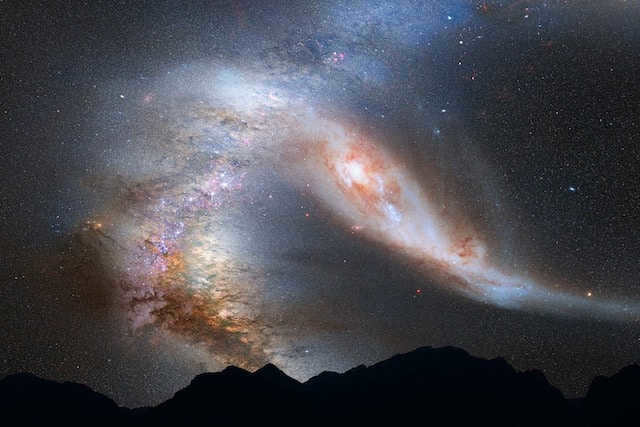
The night sky is an enchanting sight. It unveils a small portion of the immense universe – our very own Milky Way Galaxy, which astounds us with its breathtaking beauty and vastness. Whether gazing into the open expanse or peering through a telescope, one can capture images that are invisible to the naked eye from Earth. In this compilation, we invite you to marvel at and contemplate the stunning photographs of our Galaxy, while also discovering a range of fascinating facts about our cosmic abode.
Exploring the Milky Way Galaxy: Discovery and Initial Images
During the 18th century, scientists gazing at the stars from Earth made an intriguing observation – all celestial bodies appeared to orbit larger ones. Satellites circled planets, while planets revolved around the Sun. This led to the hypothesis that our Solar System, too, is part of a greater entity and rotates around a central point.
When viewed from Earth, the Milky Way presents itself as a stunningly ethereal band across the night sky. Pioneering astronomers like Galileo Galilei and Immanuel Kant put forth the idea that our star system is actually a member of an immense collection of stars. Further investigations indicated that the most prominent stars are located near the Milky Way, with only faint luminous objects being detectable beyond it. It was also proposed that the visible nebulae scattered across the sky are neighboring galaxies or clusters.
Astronomer William Herschel (known for his discovery of Uranus) verified and demonstrated that nearly all observable celestial objects are components of a vast Galaxy (derived from the Greek word “galactikos” – meaning “milky”). Images of the Milky Way from Earth, along with various individual nebulae (which are also galaxies), only capture a fraction of the visible Universe.
Subsequently, it was ascertained that the Sun is positioned quite distant from the central region of our star cluster and orbits around it. Furthermore, the Galaxy itself is in motion, traversing through space at a considerable velocity.
Milky Way in numbers and photos from Earth
Contemporary photographs of the Milky Way are highly detailed. However, it can be challenging to discern anything beyond beauty and individual stars in amateur pictures. To conduct in-depth studies, astronomers rely on ultra-precise photos captured by specialized telescopes on Earth. These telescopes can collect data and capture images across various spectral emissions, providing scientists with more accurate information about distances, masses, and stars. Numerous institutes and departments, including NASA, are dedicated to advancing our understanding of these matters.
All the data pertaining to space, the Milky Way, and extraterrestrial galaxies are provisional and subject to constant revision. Here are some figures and information (though not definitive):
- Appearance: The Milky Way is a spiral galaxy with a bar (the existence of which was confirmed in the early 2000s). The exact number of arms is still uncertain (though eight have been identified);
- The Milky Way has a size of 100 thousand light-years in diameter and 1000 sv. l. in thickness;
- It has a mass that is equivalent to 1.5 trillion solar masses;
- The center of the Milky Way is occupied by a supermassive black hole known as Sagittarius A*, which has a mass several million times greater than that of the Milky Way itself;
- The Milky Way is estimated to contain between 200-400 billion stars, although even with high-resolution photos, it is challenging to accurately calculate the exact number of objects present;
- The Milky Way completes one full rotation every 220-360 million years;
- It is believed to be at least 14 billion years old;
- The Milky Way has a velocity of 600 kilometers per hour.
All of these assumptions require further clarification, but until a new type of telescope is invented, it is impossible to gather this information from Earth.
Why is the spiral of the Galaxy not visible in the photo?
When we look at a photo of the Milky Way Galaxy, we only see a band because we are viewing it from the inside and from the edge, rather than from above or below. This is due to the position of the Solar System, including Earth.
Our native star system is just a tiny speck compared to the billions of massive stars and numerous black holes that make up the Milky Way. However, it is situated in a fortunate location that has allowed life to flourish on Earth, the third planet.
Astronomers have conducted research and discovered that the Sun enjoys exceptional conditions for its “existence”.
- It is situated at a significant distance from the center of the Milky Way Galaxy. Based on scientific calculations, the distance to the center is estimated to be between 27,000 and 28,000 light years, and to the junction it is about 35,000 light years. This places the star closer to the outer edge of the galaxy, making it impossible to observe its location from either outer space or Earth. This information has been determined by scientists.
- The solar system is positioned in the Orion arm, specifically on its inner edge, which is a branch of one of the primary arms of the galaxy. The branch is characterized by its relatively weak and sparse nature.
Thanks to the aforementioned conditions, the Earth managed to steer clear of any catastrophic events and pave the way for the emergence of intelligent life.
Genuine images of the Milky Way as seen from Earth offer us a glimpse of:
Scientists primarily study our Galaxy by comparing it with other distant clusters of stars and matter that have similar structures. The photos of the Milky Way taken from Earth cannot fully explain all the processes happening in our Galaxy.
Interesting Facts and Photos of the Milky Way
Photos of the Milky Way taken from space provide an opportunity to observe and study phenomena that were previously hidden. These photos reveal more stars and nebulae, allowing astronomers to better understand the position of our solar system within the universe. While these images are undeniably stunning, they serve a greater purpose for astronomers. Through these photos, along with mathematical analyses, studies, and powerful telescopes, scientists have uncovered many fascinating facts about our corner of outer space:
- Smaller clusters of stars in our Galaxy, known as dwarf galaxies (e.g., Magellanic Clouds, Andromeda Nebula), have been confirmed by astronomers. It is believed that there were dwarfs that were previously absorbed by the Milky Way, and there may be more nearby neighbors that will undergo this process in the future;
- New stars are continuously being born within the Galaxy, with approximately 5-7 stars forming each year. Supernova explosions, on the other hand, can only be observed a few times in a century;
- The solar system orbits around the center of the Galaxy at a speed of 220-240 km/s. It takes approximately 200,000,000 years for a complete revolution, meaning that since its formation, the Sun has completed around 28-30 rotations;
- Space photos of the Galaxy have revealed that it does not have a regular disk shape, as previously believed. Instead, it has a prominent thickening in the middle and irregular edges.
- It is estimated that there are approximately 40 to 100 billion planets in existence. Scientists have already discovered numerous star systems containing Earth-like planets;
- The Milky Way constantly attracts stars from other neighboring clusters;
- Our current observations, even with the use of telescopes, only allow us to see up to 10% of all matter;
- The remaining 90% is composed of a mysterious halo made up of invisible, yet existing, dark matter;
- Our galactic disk formed around the same time as the universe, approximately 13.6 billion years ago;
- In the future, it is possible that the Milky Way will merge or be absorbed by other galactic formations.
Now that you have seen the actual photographs of the Milky Way taken by regular individuals on Earth and with high-tech equipment, you are aware of its appearance. For an extended period, astronomers will continue their efforts to uncover the secrets of the universe, investigating its composition, origin, and ordinary people, on the other hand, can simply marvel at the breathtaking spectacle and imagine far-off worlds.

The universe we are attempting to examine is an immense and limitless expanse containing tens, hundreds, and even thousands of trillions of stars organized into specific clusters. Our planet, Earth, does not exist in isolation. We are part of the solar system, which is a tiny component and forms part of the Milky Way, a larger cosmic entity.
Our planet, along with other planets of the Milky Way, our star known as the Sun, and other stars within the Milky Way, follow a specific order and occupy designated positions within the universe. Let’s delve deeper into the structure of the Milky Way and explore its main characteristics.
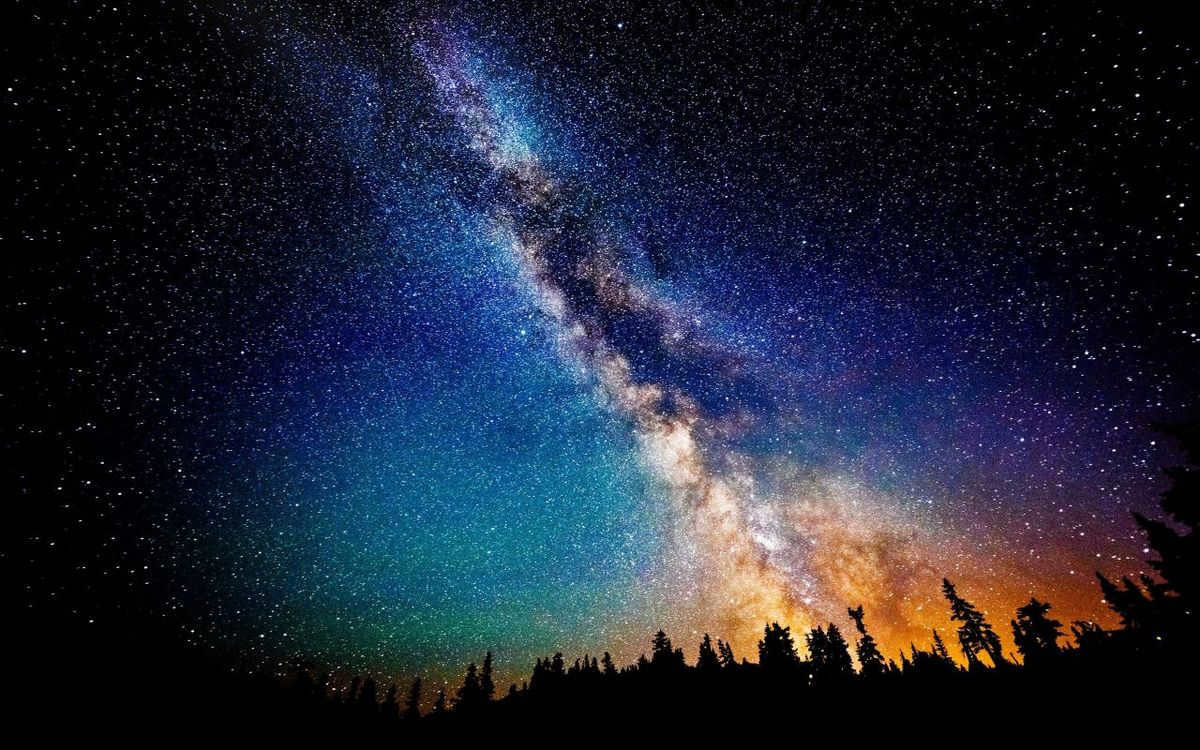
The birth of the Milky Way
Our galaxy has its own unique story, just like other regions of outer space, and it is the result of a catastrophic event on a universal scale. The prevailing theory in the scientific community today regarding the origin of the universe is known as the Big Bang. The Big Bang theory can be likened to a nuclear chain reaction at the microscopic level. Initially, there was a certain substance that, for various reasons, suddenly began to move and eventually exploded. The specific conditions that led to the initiation of this explosive reaction are beyond our comprehension. The Universe as we know it formed approximately 15 billion years ago as a result of this cataclysmic event, and it is an immense, boundless realm.
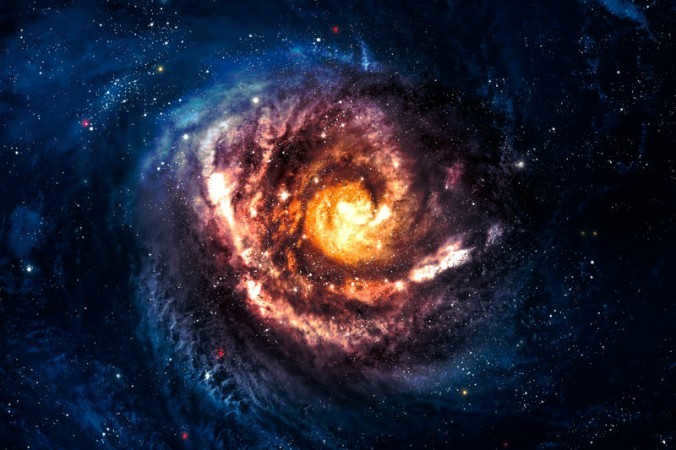
The explosion initially produced clusters and gas clouds as its primary products. Subsequently, larger objects formed on a cosmic scale due to gravitational forces and other physical processes. This entire process occurred rapidly in the context of cosmic time, taking billions of years. The first stage involved the formation of stars, which then clustered together to create galaxies, the precise number of which remains unknown. Galactic matter primarily consists of hydrogen and helium atoms, along with other elements that serve as the building blocks for the formation of stars and other celestial bodies.
Pinpointing the exact location of the Milky Way within the Universe is impossible, as the exact center of the universe remains unknown.
Because the formation processes that shaped the Universe were similar, our galaxy bears a striking resemblance to numerous others in its structure. It falls into the category of a typical spiral galaxy, a commonly seen type of celestial object throughout the Universe. In terms of its dimensions, the galaxy sits right in the middle – not too small, nor excessively large. Within our galaxy’s stellar abode, there are a plethora of smaller companions compared to those of immense proportions.
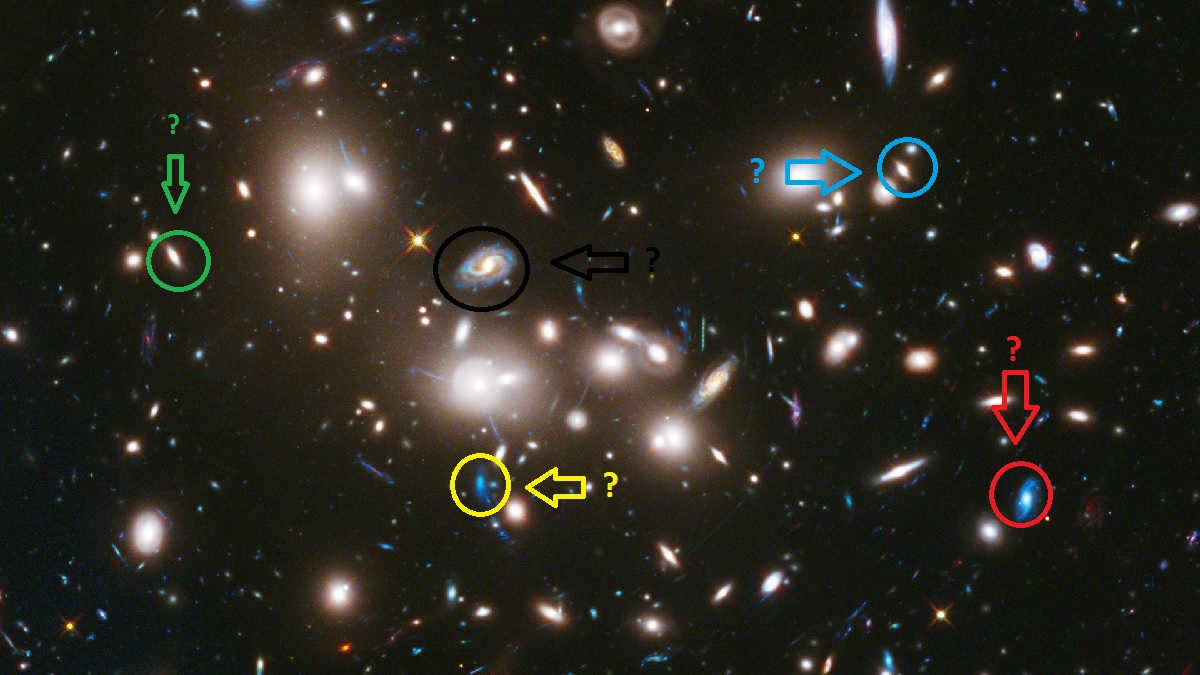
All galaxies in the vastness of outer space share a common age. The Milky Way, our very own galaxy, is nearly as old as the universe itself, with an estimated age of 14.5 billion years. Throughout this immense span of time, the structure of our galaxy has undergone numerous transformations, a process that continues to this day, albeit at a pace that is imperceptible when compared to the rapidity of life on Earth.
It’s quite intriguing to delve into the origins of the name of our galaxy. Scientists posit that the moniker “Milky Way” holds a legendary quality. It serves as an endeavor to establish a connection between the arrangement of stars in our celestial expanse and the ancient Greek myth revolving around the father of the gods, Kronos, who consumed his own offspring. The final child, destined to endure a similar tragic fate, happened to be slender and was entrusted to a nursing figure in order to fatten up. During the nurturing process, a droplet of milk inadvertently spilled into the heavens, thus giving rise to a trail of milky fluid. Subsequently, scholars and astronomers spanning various eras and cultures reached a consensus that our galaxy undeniably bears a striking resemblance to a “milky way.”
At present, the Milky Way is currently in the midst of its developmental phase. Put differently, the cosmic gas and material necessary for the creation of new stars are depleting. The current stars are still relatively youthful. Just like the narrative involving the Sun, which will likely transform into a Red Giant in approximately 6-7 billion years, our future generations will witness the metamorphosis of other stars and the entire galaxy into a red sequence.
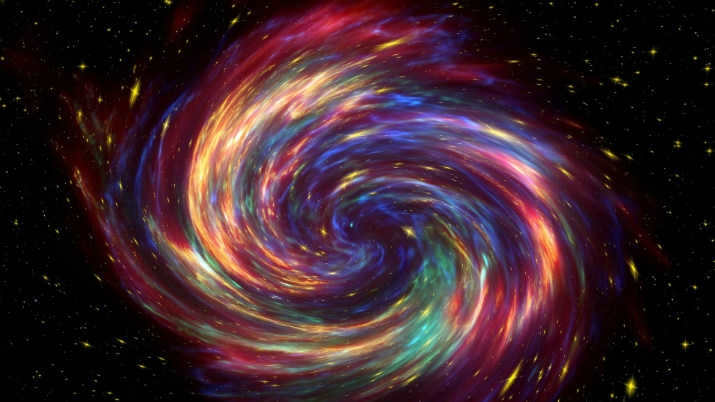

The end of our galaxy can be caused by the next universal catastrophe. The focus of recent research has been on the future encounter of the Milky Way with its closest neighbor, the Andromeda galaxy. It is possible that the Milky Way will fragment into multiple smaller galaxies after the encounter with Andromeda. In any case, this event will lead to the formation of new stars and the reorganization of our nearby space. We can only speculate about the destiny of the Universe and our galaxy in the distant future.
To get an idea of what the Milky Way looks like on a grand scale, one simply needs to observe the Universe itself and compare its various components. Our galaxy is a member of a subgroup, which is part of the Local Group, a larger structure. In this cosmic metropolis, we find the Andromeda and Triangle galaxies as our neighbors. Surrounding this trio are over 40 smaller galaxies. The Local Group itself is part of an even larger entity known as the Virgo supergroup. However, it should be noted that these locations are just estimates and not exact. The sheer size of these formations makes it incredibly difficult to comprehend them fully. At present, we only have knowledge of the distances to our nearest neighboring galaxies. Other celestial objects in deep space are beyond our visual range, and their existence can only be inferred through theoretical and mathematical calculations.
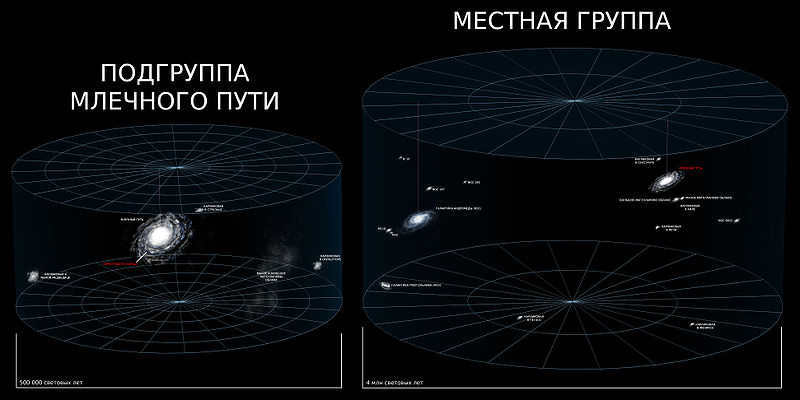
The discovery of the galaxy’s whereabouts was only made possible through approximate calculations which determined the distance to its closest companions. The Milky Way is accompanied by two dwarf galaxies known as the Small and Large Magellanic Clouds. According to scientists, there are a total of 14 satellite galaxies that comprise the entourage of the magnificent cosmic chariot known as the Milky Way.
When it comes to the observable universe, we now have sufficient information about the appearance of our galaxy. The current model, including the map of the Milky Way, is constructed based on mathematical calculations and data obtained from astrophysical observations. Each celestial body or fragment of the galaxy has its own designated position, similar to the organization of the universe on a larger scale. The astrophysical characteristics of our cosmic metropolis are both intriguing and awe-inspiring.
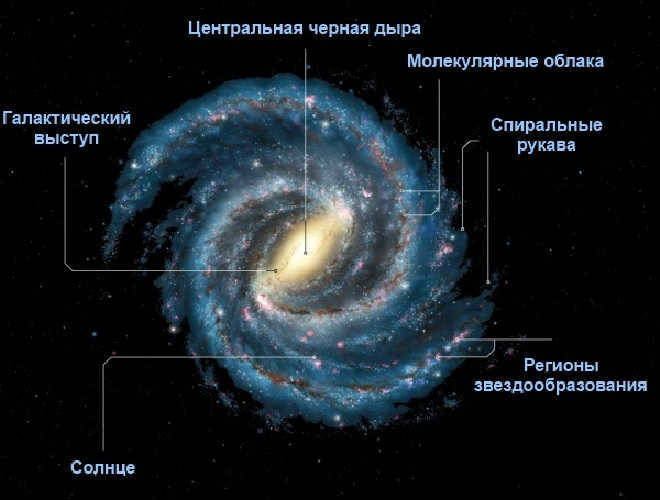
The remaining portion consists of dark matter, clusters of cosmic gas, and pockets that occupy the space between stars. As you approach the core of the galaxy, the number of stars increases, causing outer space to become denser. Our Sun resides in a region of space that is comprised of smaller celestial objects that are widely spaced apart.
The Milky Way boasts a mass of 6×1042 kg, which is trillions of times greater than the mass of our Sun. The majority of stars within our celestial home are situated within a single disk, estimated to be around 1000 light-years thick. Determining the precise mass of our galaxy is impractical, as a significant portion of the visible spectrum of stars is obstructed by the Milky Way’s arms. Furthermore, the mass of the mysterious dark matter, which occupies vast interstellar regions, remains unknown.
The Sun’s location is approximately 27 thousand light years away from the center of our galaxy. Situated on the outer edges, the Sun undergoes a fast-paced orbit around the galactic center, completing a full revolution every 240 million years.
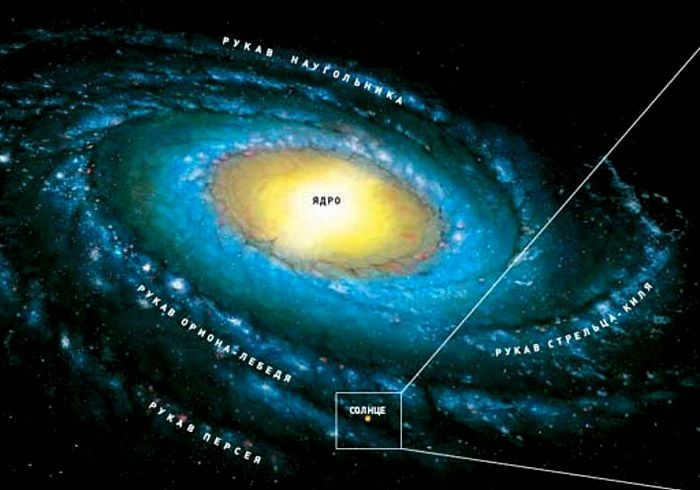
The core of the galaxy has a diameter of 1000 parsecs and is comprised of a central region with a fascinating arrangement. The core itself takes on a bulge-like shape, housing the largest stars and a cluster of luminous gases. It is within this area that a tremendous amount of energy is emitted, surpassing the combined output of the billions of stars that populate the galaxy. This segment of the core is the most active and radiant part of the galaxy. Encircling the periphery of the core is a bridge, which marks the beginning of the galaxy’s arms. This bridge forms as a result of the immense gravitational force generated by the rapid rotation of the galaxy itself.
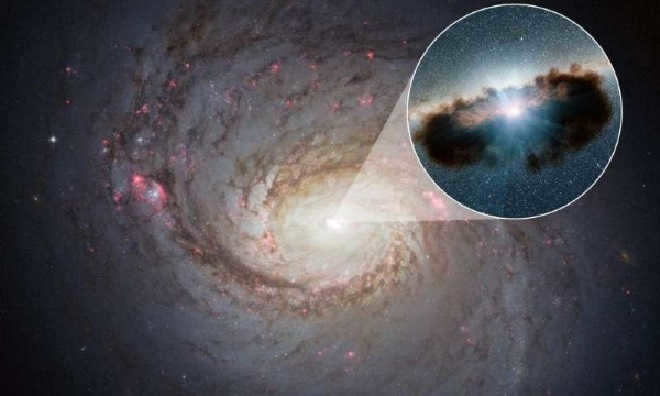
The galaxy is divided into two primary arms, known as the Centaurus Shield and Perseus Shield, which extend from its center. These distinctive features were named after the constellations that can be observed in the night sky. Additionally, the galaxy is enveloped by a total of five smaller arms.
What lies ahead
The arms of the Milky Way, which were formed at the core, extend outward, filling the expanse of space with stars and cosmic materials. This can be likened to the celestial bodies that orbit the Sun within our own solar system. On a grand scale, a vast collection of stars, ranging in size from large to small, along with clusters, nebulae, and various other celestial objects, dance around like riders on a colossal merry-go-round. Together, they create a breathtaking spectacle of the nighttime sky, which humans have marveled at for millennia. When studying our galaxy, it is important to understand that the stars within it follow their own set of rules. Today, they may be located within one of the galaxy’s arms, but tomorrow they may embark on a journey in the opposite direction, leaving one arm behind as they venture towards another.
